 Cincinnati’s City Hall is a building of a different color. It can’t be easily ignored but, although I’ve driven and walked by it countless times, I, like almost all of the participants in Thursday’s tour, had never before been inside. The building’s architect was Samuel Hannaford, who also designed Cincinnati’s Music Hall and many other buildings of note. Construction started in February of 1888. The completed building was dedicated May 13, 1893. It was placed on the National Register of Historic Places in 1972. It has been damaged by fire, insulted by, among other things, having marble wainscoting covered by wood paneling, and, like all too many not-so-new structures, threatened with demolition. I sure do appreciate it sticking around until I could finally find time for a visit.
Cincinnati’s City Hall is a building of a different color. It can’t be easily ignored but, although I’ve driven and walked by it countless times, I, like almost all of the participants in Thursday’s tour, had never before been inside. The building’s architect was Samuel Hannaford, who also designed Cincinnati’s Music Hall and many other buildings of note. Construction started in February of 1888. The completed building was dedicated May 13, 1893. It was placed on the National Register of Historic Places in 1972. It has been damaged by fire, insulted by, among other things, having marble wainscoting covered by wood paneling, and, like all too many not-so-new structures, threatened with demolition. I sure do appreciate it sticking around until I could finally find time for a visit.
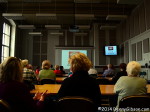 What I actually found time for was the inaugural Cincinnati Museum Center Heritage Programs Cincinnati City Hall Tour. Unbeknownst to me, tours of the building have long been available and can be arranged directly as described here. CMC Heritage Programs adds a nice presentation on the building’s and the city’s history plus arranging access to a few places not always included in the other tours.
What I actually found time for was the inaugural Cincinnati Museum Center Heritage Programs Cincinnati City Hall Tour. Unbeknownst to me, tours of the building have long been available and can be arranged directly as described here. CMC Heritage Programs adds a nice presentation on the building’s and the city’s history plus arranging access to a few places not always included in the other tours.
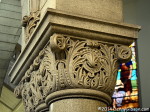
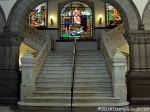
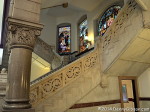 Stone from six different states (Ohio, Indiana, Wisconsin, Missouri, Tennessee, & Vermont) and Italy are used in the building. Inside, beautiful marble staircases connect the four floors with equally beautiful stained glass windows at each landing.
Stone from six different states (Ohio, Indiana, Wisconsin, Missouri, Tennessee, & Vermont) and Italy are used in the building. Inside, beautiful marble staircases connect the four floors with equally beautiful stained glass windows at each landing.
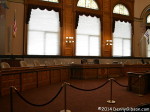
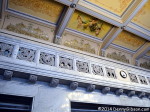
 Cincinnati’s mayor and nine member council meet weekly in this chamber. The current arrangement is a recent one. For most of the building’s existence, council met at a circular table in the middle of the room. After people protesting a 2001 police shooting completely filled the space, things were changed so that the officials sit facing the room. At one point, the ceiling was covered with acoustic which has now been removed to reveal four paintings and other details. The massive chandelier was once painted black.
Cincinnati’s mayor and nine member council meet weekly in this chamber. The current arrangement is a recent one. For most of the building’s existence, council met at a circular table in the middle of the room. After people protesting a 2001 police shooting completely filled the space, things were changed so that the officials sit facing the room. At one point, the ceiling was covered with acoustic which has now been removed to reveal four paintings and other details. The massive chandelier was once painted black.
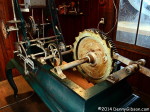
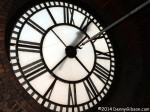
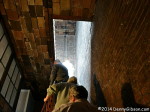 For many, most definitely including me, the highlight of the day was the tower. The clock room was near the midpoint of the climb of 109 steps.
For many, most definitely including me, the highlight of the day was the tower. The clock room was near the midpoint of the climb of 109 steps.

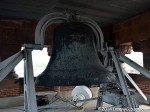 The climb continued to the open level containing the huge bell. The cube at lower right in the first picture houses the clock mechanism. A cable can be seen rising from it to control the bell’s clapper.
The climb continued to the open level containing the huge bell. The cube at lower right in the first picture houses the clock mechanism. A cable can be seen rising from it to control the bell’s clapper.
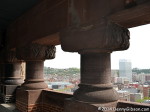
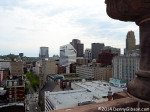
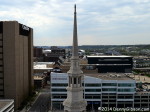 The wonderful views from the bell level include the spire of Saint Peter in Chains Cathedral, completed in 1845, backed by the recently relocated headquarters of Pure Romance. The downtown relocation of the nation’s largest seller of “relationship and intimacy aids” was not without controversy.
The wonderful views from the bell level include the spire of Saint Peter in Chains Cathedral, completed in 1845, backed by the recently relocated headquarters of Pure Romance. The downtown relocation of the nation’s largest seller of “relationship and intimacy aids” was not without controversy.

 The view in the first picture is one that the guides alerted us to before the climb. Those with a significant fear of heights can find the sight of the street far below quite unnerving. On the way up, we had paused at this level while the bell rang out 11:00 o’clock. A close look at the second picture reveals the cable running upward from the clock mechanism and the shafts connecting the mechanism to the clock faces.
The view in the first picture is one that the guides alerted us to before the climb. Those with a significant fear of heights can find the sight of the street far below quite unnerving. On the way up, we had paused at this level while the bell rang out 11:00 o’clock. A close look at the second picture reveals the cable running upward from the clock mechanism and the shafts connecting the mechanism to the clock faces.

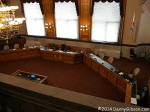 As we were for most of the tour, we divided into two groups for the tower climb. One group hung out in council chambers while the other climbed. I was part of the first set of climbers and now had the opportunity to check out the view from the gallery and make a brief power grab.
As we were for most of the tour, we divided into two groups for the tower climb. One group hung out in council chambers while the other climbed. I was part of the first set of climbers and now had the opportunity to check out the view from the gallery and make a brief power grab.

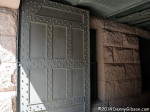 The current building replaced a much smaller one, built in 1852, on the same site. The large metal seal, mounted high in the courtyard of the current building is all that remains from the older one. Terrible riots, in which the courthouse was destroyed, had shaken Cincinnati in 1884. With that in mind, City Hall was built with something of a fortress flavor that can be seen in elements like a “watch room” in the tower and the heavy steel doors on the courtyard.
The current building replaced a much smaller one, built in 1852, on the same site. The large metal seal, mounted high in the courtyard of the current building is all that remains from the older one. Terrible riots, in which the courthouse was destroyed, had shaken Cincinnati in 1884. With that in mind, City Hall was built with something of a fortress flavor that can be seen in elements like a “watch room” in the tower and the heavy steel doors on the courtyard.
